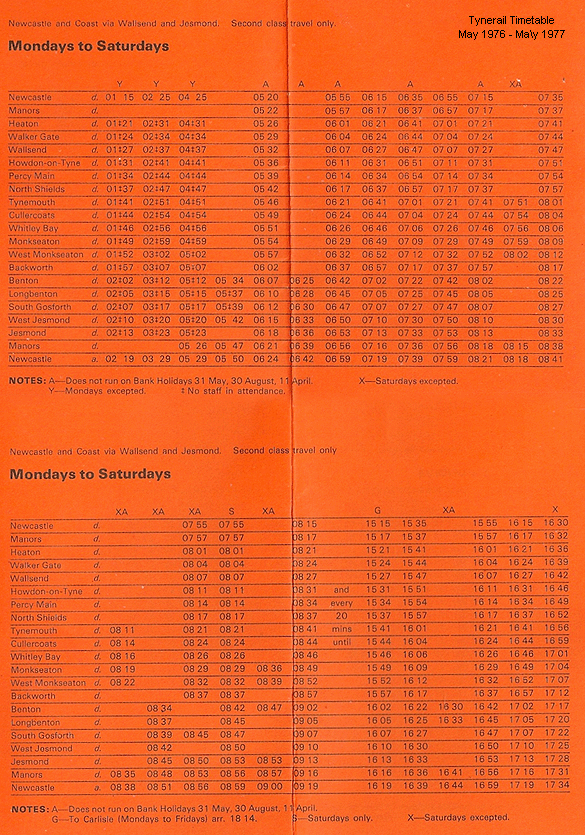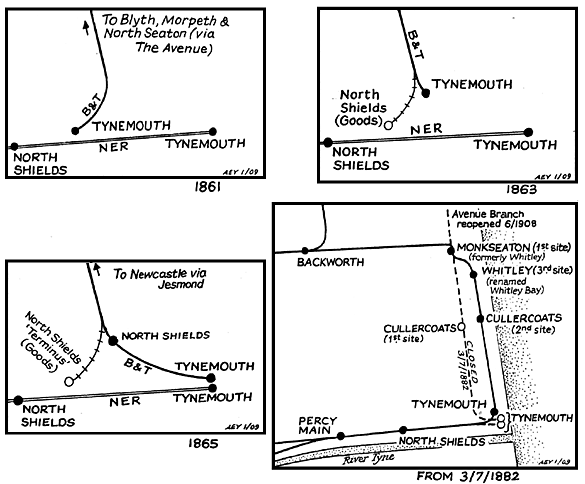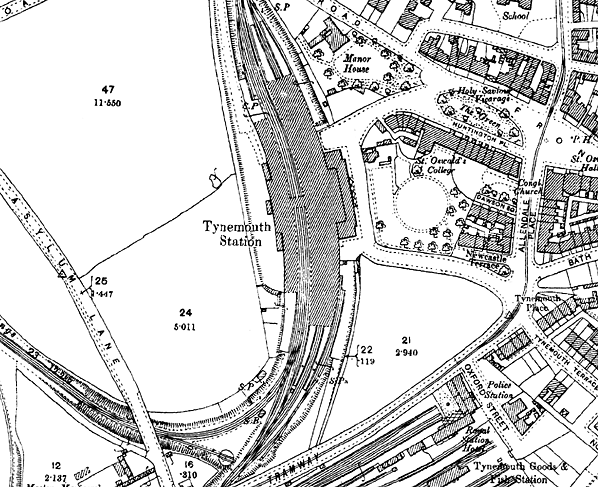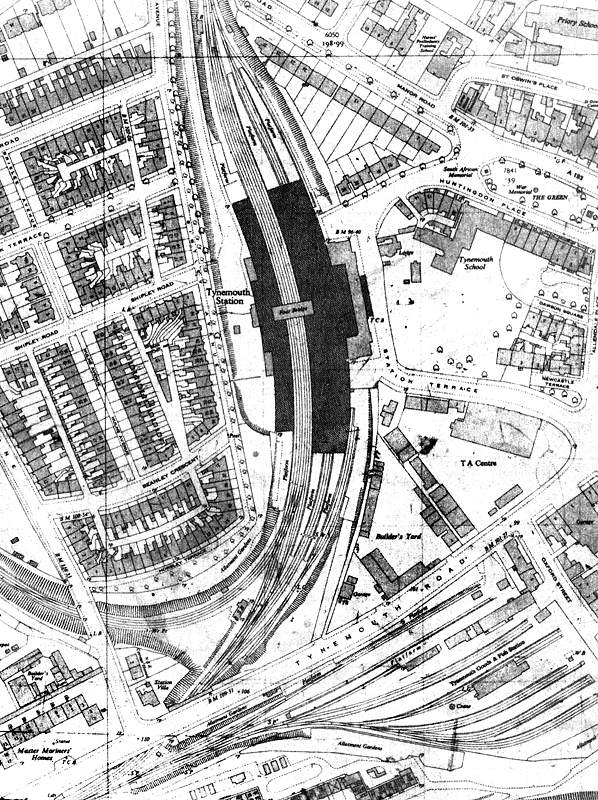Note: Writing the history of stations serving the coastal communities just north of the Tyne is a fiendishly difficult task, not recommended to the faint-hearted. Railway routes have been abandoned or adjusted, and stations have exchanged names. The phantom passenger branch to the non-existent settlement of ‘Collywell Bay’ adds an extra level of complexity. Nowhere illustrates the problems more than Tynemouth / North Shields – the need to combine these names is significant - and it is hoped that the accompanying series of maps will make sense of what changes took place in the late nineteenth century.
 |
The Newcastle & Berwick (later York, Newcastle & Berwick and North Eastern Railway) reached North Shields (or Shields as it was known then) in 1839, and pushed on into Tynemouth where it built its terminus in 1847. This Tynemouth station was in use as a passenger station until 1882 and was retained as a goods station until 1959. Its original building (Grade II |
listed) survives.
The Blyth & Tyne approached Tynemouth / North Shields from the north, opening for goods in 1860 and passengers the following year. Their terminus was called Tynemouth. However it lasted as a passenger station only until 1863, when it was demoted to a goods / coal facility and was renamed North Shields. Its replacement, called Tynemouth, was on a very short branch striking off south-eastwards, but this branch was extended in 1865 to a new, third Tynemouth station (next to the rival North Eastern Railway terminus) and the second Tynemouth station became North Shields. (The original B&T Tynemouth, as noted above, was by then called North Shields goods, and the NER still had their own North Shields station further west.)
| The situation was simplified after the NER absorbed the B&T in 1874. The NER found itself with competing facilities, facing each other across Tynemouth Road, and in 1882 they closed the B&T North Shields (ex-Tynemouth!) and the two passenger termini, replacing them all with the station which still operates on Tyne & Wear Metro. Construction of the |
 |
western approach lines to the new Tynemouth station required the removal of the ex-B&T 1865 terminus.
In the mid nineteenth century the village of Tynemouth began to attract visitors, who could enjoy the small Priors Haven (or Short Sands) beach with the remains of the priory, dissolved in 1539, on the cliff top to the south; or they could choose to visit the Long Sands bay which stretched northwards to Cullercoats, with the chalybeate spa known as Engine Well as a bonus. In 1878 the imposing Tynemouth Palace (its name from 1898 – 1927) was opened overlooking the Long Sands, first as a ‘winter gardens’ and aquarium; in later years it was variously a concert hall, skating rink, ballroom, theatre and cinema, and it accommodated a ‘soda fountain’, an amusement arcade and a night club. For most of the twentieth century it rejoiced in the name of the Plaza. Unfortunately, after a fire in 1996 it was demolished.
3.gif) |
The pier at the mouth of the Tyne, the present one completed in 1909, also lured visitors in search of some bracing sea air. Tynemouth attracted the attention of would-be commuters, and by 1914 the new station was enclosed by housing, some of it genteel – particularly the Percy Gardens area, developed by command of the Duke of Northumberland in the late |
1860s on land that he owned – but also more modest terraces. The outcome of such developments, and the inconvenience of having two passenger termini, prompted the NER to connect the two railways and open a huge new station.
Tynemouth’s new station of 1882 was designed by William Bell, the durable and gifted NER Chief Architect, in collaboration with Chief Engineer T E Harrison. Bell was also responsible for neighbouring Cullercoats, Whitley and Monkseaton stations which opened as part of the same ‘coastal’ railway route. Whitley and Monkseaton stations were later replaced with superior facilities on new sites in 1910 and 1915 respectively, also designed by Bell. Tynemouth was internally elegant and spacious. With its eight platforms and four through tracks it appeared more like a major city’s principal station; indeed, Bill Fawcett (North Eastern Railway architecture, volume 3) remarks that the station was designed ‘without overmuch concern about cost’. In addition to the two main through platforms, the up (east) side had three bays at the north end and four at the south, one of the latter being treated as a siding.
.gif) |
The frontage, on Station Terrace, in comparison to the huge footprint of the station and its sea of glazed roofing, was understated. It was a long, red brick single-storey building, like Cullercoats but on a larger scale. The hipped-roofed central pavilion stood a little taller than the wings to either side. It was embellished with iron cresting and carried a glazed verandah. Fawcett describes the fenestration as ‘Lombard pattern, with a semicircular intrados and pointed extrados’ whilst ‘those of the central pavilion [were] paired on sandstone columns with foliage capitals’. The wings ended with gabled pavilions. On the platform side the end-pavilions enclosed the spacious concourse. The south pavilion included the lamps room, a ‘store’, ash- and coal-houses, the left luggage office and ticket collectors’ room.
| As originally arranged, the south wing contained separate waiting rooms (first and second class) with toilets, for ladies, followed by the booking office and hall, a general waiting room then – unusually – a first class men’s waiting room. In the north pavilion were the gents’ toilet (shared by first and second class), the telegraph office, the stationmaster’s office and the |
 |
porters’ room.
Fawcett describes the layout on entering the station, noting that a pair of arches was to the left, originally demarcating the booking area, with three Gothic-style booking windows; however the NER changed the layout in 1931, when the general waiting room became the booking and parcels office, with a pair of the booking windows re-sited into the west wall facing the concourse. An NER tiled system map c1902 – at one time a common feature in the company’s principal stations - was displayed on the concourse.
 |
It is likely that many passengers did not study the well executed, but restrained, frontage, however they could not fail to be impressed by the vast station that opened up in front of them as they emerged from the booking hall. Prior to World War I this scene was bedecked with floral displays for which the station staff won many awards. The building was on the scale of a cathedral, |
but with a glazed roof, and a pair of wide staircases rose ahead, leading to footbridges; these staircases were separated by an inconspicuous parcels-lift which concealed a third staircase. Seen from the platforms the gently arched enclosed bridges, which appeared to be just a single bridge, formed an attractive feature. It visually united the through platforms which were separated by four railway tracks. The glazed roofing was of ridge-and-furrow design – in Fawcett’s opinion the finest surviving example in the former NER territory – with hipped ends to each ridge. A forest of columns and spandrels decorated with interlaced circles and a diamond provided visual interest, enhanced by the curve of the platforms.
The attractiveness of the station was noted both by travellers and officialdom. A visitor to the station in about 1900 commented that Tynemouth was ‘without a doubt the prettiest station of any large town in this country [with] its charming beds of flowers, its pendants of floral beauty covering its roof and hanging all over its supporting pillars’. Another visitor opined that it looked more like a garden than a railway station. Between 1900 and 1910 the staff received first, second and special prizes in the NER Best Kept Station competition. This horticultural tradition continued into LNER and British Railways days.
| This description of the station is written in the past tense, but thankfully the station is still substantially intact. When Royal Assent was given in 1973 to the conversion of the railway to light rail ‘Metro’ operation it seemed likely to spell the end of this magnificent structure, since the Metro trains with few carriages required only a couple of short platforms, basic |
 |
shelters, ticket machines, lamps and signs. Why spend huge sums on maintaining such a vast structure? It quickly became apparent that the townspeople were devoted to their station, and they obtained the support of the Fine Arts Commission and North Tyneside Council in opposing its demolition. In 1978 their case was strengthened when the buildings were granted Grade II Listing, so they remain to be enjoyed today. Even the NER titled map has survived as part of the protected structure.
Tynemouth handled large volumes of passengers, with 356,302 tickets issued in 1911 – though this was only two-thirds of Whitley Bay’s total that year. It also handled large quantities of parcels traffic, and a variety of freight was dealt with in the former Newcastle & Berwick station, where there was a 3-ton crane. This goods station closed completely on 2 March 1959. Coal traffic was handled at the original B&T terminus until 1 May 1971.
Tynemouth had three signal boxes. North and South were located beyond the ends of the down (west) platform; West was located at the entrance to the goods (late N&B) station, and it had closed by 1941.
The Coast Circle route from Newcastle Central to Jesmond, with Manors (North) replacing New Bridge Street, was opened on 1 January 1909, but until 1917 the new link was used only by Newcastle Central – Benton trains. The summer 1920 timetable shows trains every half hour throughout the day on weekdays, with a more intensive rush hour service, and an hourly service on Sundays. Express services, some of them routed via the East Coast main line between Heaton and Backworth, called at Tynemouth.
 |
By the late-1930s the half-hourly service had increased in frequency to 20-minute intervals on weekdays and half-hourly on Sundays. On summer Sundays in the mid 1950s the same frequency was provided, sometimes with ‘extras’ at particularly busy times; there were hourly Sunday trains in the winter. For many decades Tynemouth was also the destination of |
summer weekend timetabled trains for holidaymakers, a number of which originated from Glasgow. The generous provision of bay platforms was for such services, and meant that the new Whitley Bay station, only two miles away, could be constructed with only two platforms and no sidings.
In the LNER era ‘mint imperial’ style electric lamps were installed, carried on swan-neck standards or suspended beneath the platform awnings. The company’s policy was to provide small nameplates to accompany the electric lamps, which they did at Tynemouth. The LNER also fitted running-in boards of a style believed to be unique to the ‘Coast Circle’ incorporating the company’s early diamond logo. In January 1948 the station became part of the nationalised British Railways North Eastern Region, then in January 1967, when the North Eastern Region was abolished it was transferred to the Eastern Region. The LNER nameboards were in place well into the British Railways era, being replaced with tangerine vitreous enamel boards in about 1960. LNER nameplates were retained until 1971; totem signs were never fitted.
| The familiar 1937 electric multiple units on the Coast Circle were eventually condemned as ‘life expired’ by British Rail, and phased out over a two-year period to be replaced with diesel multiple units; the final EMU ran on 17 June 1967. The diesel units provided a slower service, and the longstanding 20-minute frequency of trains was reduced to half-hourly intervals; however an express service each hour called |
 'East' refers to the east ticket office 'East' refers to the east ticket office |
at Tynemouth. The new Tynerider branded services – the same old DMUs with jolly orange transfers added to them! – were introduced in October 1970, restoring the 20-minute interval service which continued to serve Tynemouth until 1980. By the early 1970s the station began to look neglected, and the bay platforms were falling out of use. In 1971 the inadequate LNER lighting was removed and tall, vandal-proof standards were installed. In 1973 black-and-white ‘corporate identity’ signage was added, and soon afterwards the tangerine running-in boards were removed.
As noted earlier, in 1973 plans to convert most of the Coast Circle to a light rail rapid transit system were approved. Whilst the other stations which were to be used as Metro ‘halts’ were closed for a period to allow engineering work to be done, Tynemouth remained open. From 23 January 1978 Newcastle Central could be reached only via Wallsend, as the section between Central and West Monkseaton was closed. From 10 September 1979 the closed section was extended from West Monkseaton to Tynemouth. Metro trains between Haymarket (temporarily the terminus in Newcastle city centre) and Tynemouth via Benton were introduced on 11 August 1980. On this date the direct line to Central via Wallsend closed for Metro conversion work, to be reopened on 14 November 1982 to a new terminus in Newcastle at St James.
9.gif) |
Returning to the story of the ‘renaissance’ of Tynemouth station, the structure was protected when it was listed in 1978 – now it is Grade II* - but there was uncertainty as to how the structure should be used. In Metro hands the up (east) platform was widened and straightened, and the track slewed into the space vacated by the two central tracks. The Friends of |
Tynemouth Station helped to devise regeneration plans which resulted in the restoration of large sections of the platform roofing in 1988-89, with attention focussed on the central portion of the building. Platform entrances were relocated between the footbridge steps, where the lifts had been. Imitation gas lamps were installed on each platform. Outside, a glazed verandah was reinstated to good effect.
Other uses for the station have been introduced since 1989. Workshop units have been established on the down platform, and on Saturdays both platforms host a market, drawing crowds to the station, reminiscent of past times. The regular market has undergone changes including the addition of a monthly Farmers' Market, but more events during Bank Holidays and midweek are planned. The Friends of Tynemouth Station hold book fairs several times a year, and they arrange displays of artwork which are regularly seen in the central section of the bridge (formerly the parcels bridge) and hanging from the roof . The old ticket office, waiting room and porters’ rooms are now used by various businesses, including a newsagent, café and restaurant.
 |
Despite these positive developments, in 2007 English Heritage placed the station on its ‘at risk’ register of notable buildings in need of restoration. In April 2009 plans for the proposed regeneration of the station were put on show to the public and local businesses and are now being considered. North Tyneside Council’s planning committee received a planning application in September 2009 for substantial redevelopment of the site. The owners of the site, Station Developments Ltd, wish to a build a 16,000 sq ft supermarket there, and carry out various improvements; a leading supermarket chain is said to have expressed interest. The insertion of a supermarket of such size is likely to have a large effect on the amenity of the surrounding area, which is a designated conservation area.
The story of Tynemouth station clearly has further paragraphs to write!
BRIEF HISTORY OF BLYTH & TYNE RAILWAY (Hartley-Monkseaton ‘Avenue Branch’; Monkseaton / Whitley Bay / Tynemouth area)
| The southern end of the Blyth & Tyne Railway has a complicated history. Until 1861 there was a single route south from Blyth and Seghill through Prospect Hill to Percy Main, with a terminus adjacent to the NER station. However that year a new branch was opened, following the route of the former Whitley Waggonway, extending from Hartley to Tynemouth. It |
 |
should be noted that this included the stretch to what is now Monkseaton, which was to be known as the ‘Avenue Branch’, and that the line beyond to Tynemouth was half a mile inland of the present day Monkseaton – Tynemouth Metro line.
At the Tynemouth end the original terminus was quickly replaced with a new one on a short branch which curved south-eastwards, and that in turn closed when its branch was extended to a third terminus, which adjoined the 1847 Tynemouth terminus of what had been the Newcastle & North Shields Railway. These developments are shown on the series of accompanying maps.
In 1864 the Blyth & Tyne reached Newcastle, with its terminus at New Bridge Street. This was achieved by diverting trains onto a new line just south of Holywell, through Backworth, Benton, and Jesmond. From Backworth a new line was opened to join the 1861 Whitley (Monkseaton) to Tynemouth route. Trains could now travel on the B&T from Newcastle (NewBridge Street) to Tynemouth, making the Holywell – Prospect Hill – Percy Main route, and the Avenue Branch between Hartley and Whitley (Monkseaton) redundant. These two lines closed in June 1864 on the day when the Newcastle – Tynemouth service was inaugurated. In June 1904 the Avenue Branch reopened to passenger traffic.
 |
In 1874 the B&T was absorbed by the NER, and the opportunity was taken to reorganise the railway routes in the Monkseaton / Whitley / Tynemouth area. With the growth of housing and holidaymaking on the coast the ‘inland’ route from Monkseaton to North Shields was superseded in 1882 by one within sight of the sea, and the two formerly competing termini at Tynemouth |
were replaced with a splendid new through station. This created the coastal section of the familiar Coast Circle and Metro route, although there were to be realignments at Whitley Bay in 1910 and Monkseaton in 1915 where new, larger stations were built.
Click here for a list of sources and a Blyth & Tyne bibliography
Tickets from Michael Stewart except 2527 & 1546 JC Dean. 1950 Bradshaw from Nick Catford. Route map drawn by Alan Young.
To see other stations on the Blyth & Tyne Railway Avenue branch click on the station name: The Avenue, Dairy House, Monkseaton (1st site), Whitley, Cullercoats (1st site), Tynemouth (1st site), North Shields (B & T) & Tynemouth (3rd site)
See also Seaton Sluice and the unopened Collywell Bay branch: Brierdene & Collywell Bay
See also
West Monkseaton, Monkseaton (2nd site), Whitley Bay (1st site), Whitley Bay (2nd site) & Cullercoats (2nd site)
See also
Tynemouth (Newcastle & Berwick terminus) |

old7.jpg)

old64.jpg)
old6.jpg)
)old62.jpg)
old39.jpg)
old48.jpg)
old63.jpg)
old58.jpg)
old59.jpg)
10.jpg)
4.jpg)
23.jpg)
25.jpg)





3.gif)
.gif)





 'East' refers to the east ticket office
'East' refers to the east ticket office 9.gif)





old8.jpg)
old4.jpg)

 Home Page
Home Page